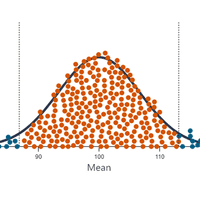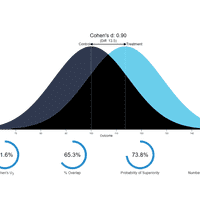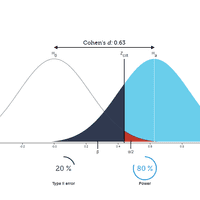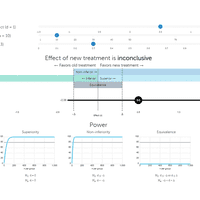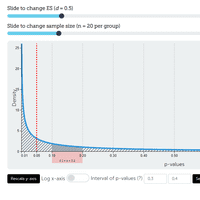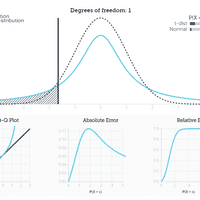Cohens d effektstorlek är otroligt populär i psykologi. Däremot är inte dess tolkning alltid helt enkelt, och forskare använder ofta generella riktlinjer, såsom låg (0.2), medel (0.5), och hög (0.8) när de tolkar effekten. I många fall är det även tveksamt om den standardiserade medelvärdesskillnaden (dvs. Cohens d) är mer tolkningsbar är den ostandardiserade skillnaden.
För att underlätta tolkningen presenteras Cohens d på några olika vis i den här visualiseringen: visuellt överlapp, Cohen’s U3, probability of superiority, procentuellt överlapp, och number needed to treat. Du kan också ändra standardavvikelsen samt se den ostandardiserade skillnaden.
Cohens U3
% Överlapp
Probability of Superiority
Number Needed to Treat
Förklaring på vanligt språk
Med en Cohens d på 0.80, kommer 78.8% av "behandling"-gruppen att vara över medelvärdet för "kontroll"-gruppen (Cohens U3), 68.9% av de två grupperna kommer överlappa, och det är en 71.4% chans att en slumpmässigt utvald person från "behandling"-gruppen kommer ha en högre poäng än en slumpmässigt utvald person från "kontroll"-gruppen (probability of superiority). För att få ett mer positivt utfall i "behandling"-gruppen jämfört med "kontroll"-gruppen behöver vi behandla 3.5 personer i genomsnitt. Detta innebär att om det är 100 personer i varje grupp, och om vi antar att 20 personer har ett positivt utfall i "kontroll"-gruppen, så kommer 20 + 28.3 personer i "behandling"-gruppen ha positiva utfall.1
1Värdena är genomsnitt, och det antas att 20 (CER) i "kontroll"-gruppen har ett "positivt utfall", d.v.s. deras utfall hamnar under någon cut-off. Du kan ändra på detta värde i inställningspanel. Mer information uträkningarna finns i formel-delen i FAQ:n.
Skrivet av Kristoffer Magnusson, forskare i klinisk psykologi. Du borde följa honom på Bluesky eller på Twitter.
FAQ
Hur använder jag den här visualiseringen?
Ändra Cohens d
Använd skjutregalget för att ändra Cohens d, eller öppna inställningspanelen och ändra parametrarna. Du kan också använda tangentbordets piltangenter för att göra ändringar.
Inställningar
Du kan ändra följande inställningar genom att klicka på inställningsikonen till höger om skjutreglaget.
- Parametrar
- Medeltal 1
- Medeltal 2
- SD
- Control group event rate (CER)
- Etiketter
- X-axeln
- Fördelning 1
- Fördelning 2
- Skjutreglagets inställningar
- Maxvärde
- Stegstorlek: Kontrollerar storleken på skjutreglaget steg
Spara inställningar
Inställningarna kan sparas i din webbläsares localStorage, och kommer därför finnas kvar vid framtida besök.
Panorera och skala om
Du kan panorera längs x-axeln genom att klicka-och-dra visualiseringen. Dubbelklicka på visualiseringen för att centrera och skala om den.
Offline-användning
Denna sida använder en service worker och kommer att fungera även när du är offline.
Vilka formler används?
Cohens d
Cohens d är helt enkelt den standardiserade medelvärdesskillnaden,
,
där är populationsparametern för Cohens d. Där det antas att , dvs., homogena populationsvarianser, och är respektive populations medelvärde.
Cohens U3
Cohen (1977) definierade U3 som ett mått på icke-överlapp, där vi “tar andelen av A-populationen som den övre halvan av fallen från Β-populationen överstiger”. Cohens d kan konverteras till Cohens U3 genom följande formel
,
där är standardnormalfördelningens kumulativ fördelningsfunktion, och populationsvärdet för Cohens d.
Överlapp
Kallas generellt för overlapping coefficient (OVL). Cohens d kan konverteras till OVL genom följande formel (Reiser and Faraggi, 1999),
där standardnormalfördelningens kumulativ fördelningsfunktion, och populationsvärdet för Cohens d.
Probability of superiority
Detta är en effektstorlek med många namn: common language effect size (CL), Area under the receiver operating characteristics (AUROC) eller bara A för sin icke-parametriska version (Ruscio & Mullen, 2012). Det är tänkt som en mer intuitivt effektstorlek för personer utan träning i statistik. Effektstorlek ger sannolikheten att en slumpmässigt utvald person från behandlingsgruppen kommer ha en högre poäng än en slumpmässigt utvald person från kontrollgruppen. Cohens d kan konvertas till CL genom följande formel (Ruscio, 2008),
där standardnormalfördelningens kumulativ fördelningsfunktion, och populationsvärdet för Cohens d.
Number Needed to Treat
NNT är antalet patienter vi skulle behöva behandla för att få ett mer positivt utfall i behandlingsgruppen jämfört med kontrollgruppen. Furukawa och Leucht (2011) gav följande formel för att konvert Cohens d till NNT,
där är standardnormalfördelningens kumulativ fördelningsfunktion och dess invers, CER är kontrollgruppens händelsefrekvens och populationsvärdet för Cohens d. OBS. CER är 20 % i visualiseringen. Du kan ändra på detta genom att trycka på inställningsikonen till höger om skjutreglaget. Definitionen av en “händelse” eller “respons” är godtyckligt, och skulle kunna definieras som proportionen patienter i remission, t.ex. de som faller under en viss gräns på ett standardiserat formulär. Det är möjligt att konvertera Cohens d till en version av NNT som ignorerar kontrollgruppens händelsefrekvens. Om du vill läsa mer om det kan du gå till Furukawa and Leucht (2011), som presenterar ett övertygande argument om varför det komplicerar tolkningen av NNT.
R-kod för att beräkna NNT från Cohens d
Eftersom många har bett om R-kod för formel här ovanför så kommer det här
CER <- 0.2d <- 0.21 / (pnorm(d + qnorm(CER))-CER)Referenser
- Baguley, T. (2009). Standardized or simple effect size: what should be reported? British journal of psychology, 100(Pt 3), 603–17.
- Cohen, J. (1977). Statistical power analysis for the behavioral sciencies. Routledge.
- Furukawa, T. A., & Leucht, S. (2011). How to obtain NNT from Cohen’s d: comparison of two methods. PloS one, 6(4).
- Reiser, B., & Faraggi, D. (1999). Confidence intervals for the overlapping coefficient: the normal equal variance case. Journal of the Royal Statistical Society, 48(3), 413-418.
- Ruscio, J. (2008). A probability-based measure of effect size: robustness to base rates and other factors. Psychological methods, 13(1), 19–30.
- Ruscio, J., & Mullen, T. (2012). Confidence Intervals for the Probability of Superiority Effect Size Measure and the Area Under a Receiver Operating Characteristic Curve. Multivariate Behavioral Research, 47(2), 201–223.
Hur refererar jag till den här sidan?
Referera till den här sidan utifrån din favoritstilguide. Referensen här nedanför är automatiskt genererad och innehåller korrekt information.
APA 7
Magnusson, K. (2023). A Causal Inference Perspective on Therapist Effects. PsyArXiv. https://DOI
BibTex
@article{magnussonCausalTherapistEffects, doi = {XXX}, url = {XXX}, year = 2023, month = {jun}, publisher = {PsyArXiv}, volume = {}, number = {}, pages = {}, author = {Kristoffer Magnusson}, title = {A Causal Inference Perspective on Therapist Effects}, journal = {PsyArXiv}}Jag har upptäckt en bugg!
Rapportera gärna buggar eller skicka förslag genom att öppna ett ärende på GitHub, om du vill ställa en fråga använd GitHub discussions
Jag kommer be en stor grupp studenter att besöka den här sidan, kommer de att krascha servern?
Nej, det är ingen fara! Den här appen körs i din webbläsare och servern behöver bara skicka några små filer.
Överlappsstatistiken skiljer sig från Cohens beräkningar
Detta är medvetet, du kan läsa mer om jag resonerar i det här blogginlägget: Where Cohen went wrong – the proportion of overlap between two normal distributions
Får jag inkludera den här visualiseringen i min bok/artikel/etc?
Ja, absolut! Jag har inte uppfunnit hur man ritar två överlappande Gaussianfördelningar. Visualiseringen på den här sidan är dedikerat till public domain, vilket innebär att du kan “kopiera, modifiera, distribuera och framföra verket, även i kommersiellt syfte, utan att fråga om lov” (see [CC0 1.0 universell Public domain-dedikation](https://creativecommons.org/publicdomain/zero/1.0/deed.sv)). Erkännande är inte ett krav men alltid uppskattat!
Källkoden för visualiseringen har en MIT-licens, och textinnehållet är CC-BY 4.0.
Bidra/Donera
De finns många sätt att bidra till fri och öppen mjukvara. Om du gillar det jag gör och vill stödja det kan du:
Ett stort tack till de 175 personer som bjudit på 422 kaffe!
Steffen köpte ☕☕☕☕☕☕☕☕☕☕☕☕ (12) kaffe
I love your visualizations. Some of the best out there!!!
Jason Rinaldo köpte ☕☕☕☕☕☕☕☕☕☕ (10) kaffe
I've been looking for applets that show this for YEARS, for demonstrations for classes. Thank you so much! Students do not need to tolarate my whiteboard scrawl now. I'm sure they'd appreciate you, too.l
Shawn Bergman köpte ☕☕☕☕☕ (5) kaffe
Thank you for putting this together! I am using these visuals and this information to teach my Advanced Quant class.
anthonystevendick@gmail.com köpte ☕☕☕☕☕ (5) kaffe
I've been using a lot of your ideas in a paper I'm writing and even borrowed some of your code (cited of course). But this site has been so helpful I think, in addition, I owe you a few coffees!
Chip Reichardt köpte ☕☕☕☕☕ (5) kaffe
Hi Krisoffer, these are great applets and I've examined many. I'm writing a chapter for the second edition of "Teaching statistics and quantitative methods in the 21st century" by Joe Rodgers (Routledge). My chapter is on the use of applets in teaching statistics. I could well be describing 5 of yours. Would you permit me to publish one or more screen shots of the output from one or more of your applets. I promise I will be saying very positive things about your applets. If you are inclined to respond, my email address if Chip.Reichardt@du.edu.
Someone köpte ☕☕☕☕☕ (5) kaffe
Someone köpte ☕☕☕☕☕ (5) kaffe
Nice work! Saw some of your other publications and they are also really intriguing. Thanks so much!
JDMM köpte ☕☕☕☕☕ (5) kaffe
You finally helped me understand correlation! Many, many thanks... 😄
@VicCazares köpte ☕☕☕☕☕ (5) kaffe
Good stuff! It's been so helpful for teaching a Psych Stats class. Cheers!
Dustin M. Burt köpte ☕☕☕☕☕ (5) kaffe
Excellent and informative visualizations!
Someone köpte ☕☕☕☕☕ (5) kaffe
@metzpsych köpte ☕☕☕☕☕ (5) kaffe
Always the clearest, loveliest simulations for complex concepts. Amazing resource for teaching intro stats!
Ryo köpte ☕☕☕☕☕ (5) kaffe
For a couple years now I've been wanting to create visualizations like these as a way to commit these foundational concepts to memory. But after finding your website I'm both relieved that I don't have to do that now and pissed off that I couldn't create anything half as beautiful and informative as you have done here. Wonderful job.
Diarmuid Harvey köpte ☕☕☕☕☕ (5) kaffe
You have an extremely useful site with very accessible content that I have been using to introduce colleagues and students to some of the core concepts of statistics. Keep up the good work, and thanks!
Michael Hansen köpte ☕☕☕☕☕ (5) kaffe
Keep up the good work!
Michael Villanueva köpte ☕☕☕☕☕ (5) kaffe
I wish I could learn more from you about stats and math -- you use language in places that I do not understand. Cohen's D visualizations opened my understanding. Thank you
Someone köpte ☕☕☕☕☕ (5) kaffe
Thank you, Kristoffer
Pål from Norway köpte ☕☕☕☕☕ (5) kaffe
Great webpage, I use it to illustrate several issues when I have a lecture in research methods. Thanks, it is really helpful for the students:)
@MAgrochao köpte ☕☕☕☕☕ (5) kaffe
Joseph Bulbulia köpte ☕☕☕☕☕ (5) kaffe
Hard to overstate the importance of this work Kristoffer. Grateful for all you are doing.
@TDmyersMT köpte ☕☕☕☕☕ (5) kaffe
Some really useful simulations, great teaching resources.
@lakens köpte ☕☕☕☕☕ (5) kaffe
Thanks for fixing the bug yesterday!
@LinneaGandhi köpte ☕☕☕☕☕ (5) kaffe
This is awesome! Thank you for creating these. Definitely using for my students, and me! :-)
@ICH8412 köpte ☕☕☕☕☕ (5) kaffe
very useful for my students I guess
@KelvinEJones köpte ☕☕☕☕☕ (5) kaffe
Preparing my Master's student for final oral exam and stumbled on your site. We are discussing in lab meeting today. Coffee for everyone.
Someone köpte ☕☕☕☕☕ (5) kaffe
What a great site
@Daniel_Brad4d köpte ☕☕☕☕☕ (5) kaffe
Wonderful work!
David Loschelder köpte ☕☕☕☕☕ (5) kaffe
Terrific work. So very helpful. Thank you very much.
@neilmeigh köpte ☕☕☕☕☕ (5) kaffe
I am so grateful for your page and can't thank you enough!
@giladfeldman köpte ☕☕☕☕☕ (5) kaffe
Wonderful work, I use it every semester and it really helps the students (and me) understand things better. Keep going strong.
Dean Norris köpte ☕☕☕☕☕ (5) kaffe
Sal köpte ☕☕☕☕☕ (5) kaffe
Really super useful, especially for teaching. Thanks for this!
dde@paxis.org köpte ☕☕☕☕☕ (5) kaffe
Very helpful to helping teach teachers about the effects of the Good Behavior Game
@akreutzer82 köpte ☕☕☕☕☕ (5) kaffe
Amazing visualizations! Thank you!
@rdh_CLE köpte ☕☕☕☕☕ (5) kaffe
So good!
tchipman1@gsu.edu köpte ☕☕☕ (3) kaffe
Hey, your stuff is cool - thanks for the visual
Hugo Quené köpte ☕☕☕ (3) kaffe
Hi Kristoffer, Some time ago I've come up with a similar illustration about CIs as you have produced, and I'm now also referring to your work:<br>https://hugoquene.github.io/QMS-EN/ch-testing.html#sec:t-confidenceinterval-mean<br>With kind regards, Hugo Quené<br>(Utrecht University, Netherlands)
Tor köpte ☕☕☕ (3) kaffe
Thanks so much for helping me understand these methods!
Amanda Sharples köpte ☕☕☕ (3) kaffe
Soyol köpte ☕☕☕ (3) kaffe
Someone köpte ☕☕☕ (3) kaffe
Kenneth Nilsson köpte ☕☕☕ (3) kaffe
Keep up the splendid work!
@jeremywilmer köpte ☕☕☕ (3) kaffe
Love this website; use it all the time in my teaching and research.
Someone köpte ☕☕☕ (3) kaffe
Powerlmm was really helpful, and I appreciate your time in putting such an amazing resource together!
DR AMANDA C DE C WILLIAMS köpte ☕☕☕ (3) kaffe
This is very helpful, for my work and for teaching and supervising
Georgios Halkias köpte ☕☕☕ (3) kaffe
Regina köpte ☕☕☕ (3) kaffe
Love your visualizations!
Susan Evans köpte ☕☕☕ (3) kaffe
Thanks. I really love the simplicity of your sliders. Thanks!!
@MichaMarie8 köpte ☕☕☕ (3) kaffe
Thanks for making this Interpreting Correlations: Interactive Visualizations site - it's definitely a great help for this psych student! 😃
Zakaria Giunashvili, from Georgia köpte ☕☕☕ (3) kaffe
brilliant simulations that can be effectively used in training
Someone köpte ☕☕☕ (3) kaffe
@PhysioSven köpte ☕☕☕ (3) kaffe
Amazing illustrations, there is not enough coffee in the world for enthusiasts like you! Thanks!
Cheryl@CurtinUniAus köpte ☕☕☕ (3) kaffe
🌟What a great contribution - thanks Kristoffer!
vanessa moran köpte ☕☕☕ (3) kaffe
Wow - your website is fantastic, thank you for making it.
Someone köpte ☕☕☕ (3) kaffe
mikhail.saltychev@gmail.com köpte ☕☕☕ (3) kaffe
Thank you Kristoffer This is a nice site, which I have been used for a while. Best Prof. Mikhail Saltychev (Turku University, Finland)
Someone köpte ☕☕☕ (3) kaffe
Ruslan Klymentiev köpte ☕☕☕ (3) kaffe
@lkizbok köpte ☕☕☕ (3) kaffe
Keep up the nice work, thank you!
@TELLlab köpte ☕☕☕ (3) kaffe
Thanks - this will help me to teach tomorrow!
SCCT/Psychology köpte ☕☕☕ (3) kaffe
Keep the visualizations coming!
@elena_bolt köpte ☕☕☕ (3) kaffe
Thank you so much for your work, Kristoffer. I use your visualizations to explain concepts to my tutoring students and they are a huge help.
A random user köpte ☕☕☕ (3) kaffe
Thank you for making such useful and pretty tools. It not only helped me understand more about power, effect size, etc, but also made my quanti-method class more engaging and interesting. Thank you and wish you a great 2021!
@hertzpodcast köpte ☕☕☕ (3) kaffe
We've mentioned your work a few times on our podcast and we recently sent a poster to a listener as prize so we wanted to buy you a few coffees. Thanks for the great work that you do!Dan Quintana and James Heathers - Co-hosts of Everything Hertz
Cameron Proctor köpte ☕☕☕ (3) kaffe
Used your vizualization in class today. Thanks!
eshulman@brocku.ca köpte ☕☕☕ (3) kaffe
My students love these visualizations and so do I! Thanks for helping me make stats more intuitive.
Someone köpte ☕☕☕ (3) kaffe
Adrian Helgå Vestøl köpte ☕☕☕ (3) kaffe
@misteryosupjoo köpte ☕☕☕ (3) kaffe
For a high school teacher of psychology, I would be lost without your visualizations. The ability to interact and manipulate allows students to get it in a very sticky manner. Thank you!!!
Chi köpte ☕☕☕ (3) kaffe
You Cohen's d post really helped me explaining the interpretation to people who don't know stats! Thank you!
Someone köpte ☕☕☕ (3) kaffe
You doing useful work !! thanks !!
@ArtisanalANN köpte ☕☕☕ (3) kaffe
Enjoy.
@jsholtes köpte ☕☕☕ (3) kaffe
Teaching stats to civil engineer undergrads (first time teaching for me, first time for most of them too) and grasping for some good explanations of hypothesis testing, power, and CI's. Love these interactive graphics!
@notawful köpte ☕☕☕ (3) kaffe
Thank you for using your stats and programming gifts in such a useful, generous manner. -Jess
Mateu Servera köpte ☕☕☕ (3) kaffe
A job that must have cost far more coffees than we can afford you ;-). Thank you.
@cdrawn köpte ☕☕☕ (3) kaffe
Thank you! Such a great resource for teaching these concepts, especially CI, Power, correlation.
Julia köpte ☕☕☕ (3) kaffe
Fantastic work with the visualizations!
@felixthoemmes köpte ☕☕☕ (3) kaffe
@dalejbarr köpte ☕☕☕ (3) kaffe
Your work is amazing! I use your visualizations often in my teaching. Thank you.
@PsychoMouse köpte ☕☕☕ (3) kaffe
Excellent! Well done! SOOOO Useful!😊 🐭
Someone köpte ☕☕ (2) kaffe
Thanks, your work is great!!
Dan Sanes köpte ☕☕ (2) kaffe
this is a superb, intuitive teaching tool!
@whlevine köpte ☕☕ (2) kaffe
Thank you so much for these amazing visualizations. They're a great teaching tool and the allow me to show students things that it would take me weeks or months to program myself.
Someone köpte ☕☕ (2) kaffe
@notawful köpte ☕☕ (2) kaffe
Thank you for sharing your visualization skills with the rest of us! I use them frequently when teaching intro stats.
Someone köpte ☕ (1) kaffe
You are awesome
Thom Marchbank köpte ☕ (1) kaffe
Your visualisations are so useful! Thank you so much for your work.
georgina g. köpte ☕ (1) kaffe
thanks for helping me in my psych degree!
Someone köpte ☕ (1) kaffe
Thank You for this work.
Kosaku Noba köpte ☕ (1) kaffe
Nice visualization, I bought a cup of coffee.
Someone köpte ☕ (1) kaffe
Thomas köpte ☕ (1) kaffe
Great. Use it for teaching in psychology.
Someone köpte ☕ (1) kaffe
It is the best statistics visualization so far!
Ergun Pascu köpte ☕ (1) kaffe
AMAZING Tool!!! Thank You!
Ann Calhoun-Sauls köpte ☕ (1) kaffe
This has been a wonderful resource for my statistics and research methods classes. I also occassionally use it for other courses such as Theories of Personality and Social Psychology
David Britt köpte ☕ (1) kaffe
nicely reasoned
Mike köpte ☕ (1) kaffe
I appreciate your making this site available. Statistics are not in my wheelhouse, but the ability to display my data more meaningfully in my statistics class is both educational and visually appealing. Thank you!
Jayne T Jacobs köpte ☕ (1) kaffe
Andrew J O'Neill köpte ☕ (1) kaffe
Thanks for helping understand stuff!
Someone köpte ☕ (1) kaffe
Someone köpte ☕ (1) kaffe
Shawn Hemelstrand köpte ☕ (1) kaffe
Thank you for this great visual. I use it all the time to demonstrate Cohen's d and why mean differences affect it's approximation.
Adele Fowler-Davis köpte ☕ (1) kaffe
Thank you so much for your excellent post on longitudinal models. Keep up the good work!
Stewart köpte ☕ (1) kaffe
This tool is awesome!
Someone köpte ☕ (1) kaffe
Aidan Nelson köpte ☕ (1) kaffe
Such an awesome page, Thank you
Someone köpte ☕ (1) kaffe
Ellen Kearns köpte ☕ (1) kaffe
Dr Nazam Hussain köpte ☕ (1) kaffe
Someone köpte ☕ (1) kaffe
Eva köpte ☕ (1) kaffe
I've been learning about power analysis and effect sizes (trying to decide on effect sizes for my planned study to calculate sample size) and your Cohen's d interactive tool is incredibly useful for understanding the implications of different effect sizes!
Someone köpte ☕ (1) kaffe
Someone köpte ☕ (1) kaffe
Thanks a lot!
Someone köpte ☕ (1) kaffe
Reena Murmu Nielsen köpte ☕ (1) kaffe
Tony Andrea köpte ☕ (1) kaffe
Thanks mate
Tzao köpte ☕ (1) kaffe
Thank you, this really helps as I am a stats idiot :)
Melanie Pflaum köpte ☕ (1) kaffe
Sacha Elms köpte ☕ (1) kaffe
Yihan Xu köpte ☕ (1) kaffe
Really appreciate your good work!
@stevenleung köpte ☕ (1) kaffe
Your visualizations really help me understand the math.
Junhan Chen köpte ☕ (1) kaffe
Someone köpte ☕ (1) kaffe
Someone köpte ☕ (1) kaffe
Michael Hansen köpte ☕ (1) kaffe
ALEXANDER VIETHEER köpte ☕ (1) kaffe
mather köpte ☕ (1) kaffe
Someone köpte ☕ (1) kaffe
Bastian Jaeger köpte ☕ (1) kaffe
Thanks for making the poster designs OA, I just hung two in my office and they look great!
@ValerioVillani köpte ☕ (1) kaffe
Thanks for your work.
Someone köpte ☕ (1) kaffe
Great work!
@YashvinSeetahul köpte ☕ (1) kaffe
Someone köpte ☕ (1) kaffe
Angela köpte ☕ (1) kaffe
Thank you for building such excellent ways to convey difficult topics to students!
@inthelabagain köpte ☕ (1) kaffe
Really wonderful visuals, and such a fantastic and effective teaching tool. So many thanks!
Someone köpte ☕ (1) kaffe
Someone köpte ☕ (1) kaffe
Yashashree Panda köpte ☕ (1) kaffe
I really like your work.
Ben köpte ☕ (1) kaffe
You're awesome. I have students in my intro stats class say, "I get it now," after using your tool. Thanks for making my job easier.
Gabriel Recchia köpte ☕ (1) kaffe
Incredibly useful tool!
Shiseida Sade Kelly Aponte köpte ☕ (1) kaffe
Thanks for the assistance for RSCH 8210.
@Benedikt_Hell köpte ☕ (1) kaffe
Great tools! Thank you very much!
Amalia Alvarez köpte ☕ (1) kaffe
@noelnguyen16 köpte ☕ (1) kaffe
Hi Kristoffer, many thanks for making all this great stuff available to the community!
Eran Barzilai köpte ☕ (1) kaffe
These visualizations are awesome! thank you for creating it
Someone köpte ☕ (1) kaffe
Chris SG köpte ☕ (1) kaffe
Very nice.
Gray Church köpte ☕ (1) kaffe
Thank you for the visualizations. They are fun and informative.
Qamar köpte ☕ (1) kaffe
Tanya McGhee köpte ☕ (1) kaffe
@schultemi köpte ☕ (1) kaffe
Neilo köpte ☕ (1) kaffe
Really helpful visualisations, thanks!
Someone köpte ☕ (1) kaffe
This is amazing stuff. Very slick.
Someone köpte ☕ (1) kaffe
Sarko köpte ☕ (1) kaffe
Thanks so much for creating this! Really helpful for being able to explain effect size to a clinician I'm doing an analysis for.
@DominikaSlus köpte ☕ (1) kaffe
Thank you! This page is super useful. I'll spread the word.
Someone köpte ☕ (1) kaffe
Melinda Rice köpte ☕ (1) kaffe
Thank you so much for creating these tools! As we face the challenge of teaching statistical concepts online, this is an invaluable resource.
@tmoldwin köpte ☕ (1) kaffe
Fantastic resource. I think you would be well served to have one page indexing all your visualizations, that would make it more accessible for sharing as a common resource.
Someone köpte ☕ (1) kaffe
Fantastic Visualizations! Amazing way to to demonstrate how n/power/beta/alpha/effect size are all interrelated - especially for visual learners! Thank you for creating this?
@jackferd köpte ☕ (1) kaffe
Incredible visualizations and the best power analysis software on R.
Cameron Proctor köpte ☕ (1) kaffe
Great website!
Someone köpte ☕ (1) kaffe
Hanah Chapman köpte ☕ (1) kaffe
Thank you for this work!!
Someone köpte ☕ (1) kaffe
Jayme köpte ☕ (1) kaffe
Nice explanation and visual guide of Cohen's d
Bart Comly Boyce köpte ☕ (1) kaffe
thank you
Dr. Mitchell Earleywine köpte ☕ (1) kaffe
This site is superb!
Florent köpte ☕ (1) kaffe
Zampeta köpte ☕ (1) kaffe
thank you for sharing your work.
Mila köpte ☕ (1) kaffe
Thank you for the website, made me smile AND smarter :O enjoy your coffee! :)
Deb köpte ☕ (1) kaffe
Struggling with statistics and your interactive diagram made me smile to see that someone cares enough about us strugglers to make a visual to help us out!😍
Someone köpte ☕ (1) kaffe
@exerpsysing köpte ☕ (1) kaffe
Much thanks! Visualizations are key to my learning style!
Someone köpte ☕ (1) kaffe
Sponsorer
Du kan sponsra mitt open source-arbete genom GitHub Sponsors och bli tackad här.
Stödjare ✨❤️
Pull requests är också välkomna, eller så kan du föreslå nya funktioner, referenser, eller fixa stavfel. Öppna bara ett ärende på GitHub.
Fler Visualiseringar
Statistical Power and Significance Testing
An interactive version of the traditional Type I and II error illustration.
Equivalence and Non-Inferiority Testing
Explore how superiority, non-inferiority, and equivalence testing relates to a confidence interval

